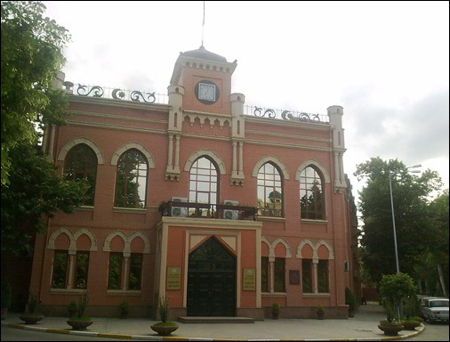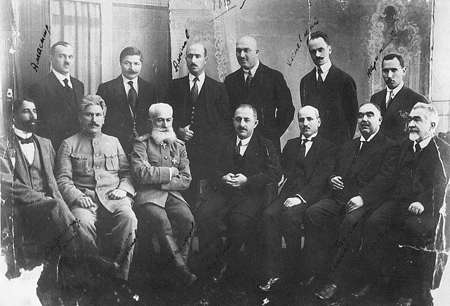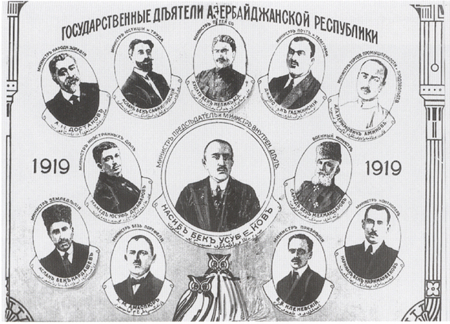Government
Government and its composition
The Government was a supreme executive power in the Azerbaijan Democratic Republic. It was responsible to parliament. The Government carried out the legislative activities during the period when the National Council of Azerbaijan suspended its activity. The article 6 of the Declaration of Independence of Azerbaijan reads as follows: “Until the parliament is convoked, the governance of Azerbaijan belongs to the National Council and the provisional Government which is responsible to the National Council”.
The National Council assigned the member of the National Council, independent Fatali Khan Khoyski to form the first cabinet of Azerbaijan Democratic Republic. Fatali Khan Khoyski assumed the positions of the Chairman of Council of Ministers and the Minister of Internal Affairs in the first cabinet.
On May 30, 1918, the Government of Azerbaijan Democratic Republic sent an official statement on proclamation of independence of Azerbaijan over the wireless to the main political centres of the world. The radiogram reportedly said that, the newly established Government temporarily located in Yelizavetpol (Ganja).
The National Council and Government of Azerbaijan moved to Ganja on June 16, 1918. At the second meeting of the National Council on Ju

ne 17, Fatali Khan Khoyski briefly informed the members of the Council and asked to accept the resignation of his cabinet. After a long discussion, the meeting adopted two important resolutions on dissolution of the Azerbaijani National Council and delegation of all the legislative and executive power to the newly formed Provisional Government of Azerbaijan. It was decided to convene the Assembly of Enterprises within 6 months. The Government was free to exercise its authority in other issues.
On June 17, the National Council of Azerbaijan approved the composition of the second cabinet of Azerbaijan Democratic Republic under the leadership of Fatali Khan Khoyski. Council of Ministers and administrative personnel of the separate ministries were formed. On June 27, Azerbaijani was declared the state language. On August 28, a resolution was passed on nationalization of educational institutions.
On September 15, 1918, Caucasus Islam Army consisted of Azerbaijan and Turkish military forces liberated Baku from dashnak-bolshevik forces. On September 17, the Government of the Azerbaijan Democratic Republic moved to Baku. On October 6, 1918, there were made changes in the second government formed by Fatali Khan Khoyski and positions were again distributed.
A commission composed of the chairman of the Council of Ministers, ministers of internal affairs and education was set up in order to arrange the convocation of the Assembly of Enterprises. On November 9, 1918, the Government of Azerbaijan approved the tricolour of the country.

Cabinet of Ministers. April, 1919
The first session of the parliament of Azerbaijan Democratic Republic was held on December 7, 1918. After the election of the governing bodies of the parliament, the chairman of the Government of Azerbaijan Democratic Republic Fatali Khan Khoyski was given the floor to submit a report about the activity of the government. He gave a detailed account on the works done by his government in the very complicated historical situation. Fatali Khan Khoyski asked the newly established parliament to accept the resignation of his government. Parliament accepted the resignation of the second government. Fatali Khan Khoyski was again commissioned to form and administer the new government, third in number. On December 26, Fatali Khan Khoyski spoke in the parliament with the program and composition of the third government. After the discussions the parliament expressed its confidence in the government headed by Fatali Khan Khoyski.
The government of Fatali Khan Khoyski was subjected to severe criticism at the sessions of the parliament held in January-February, 1919. Fatali Khan Khoyski did not admit the unfair remarks and submitted his letter of resignation to the parliament. The resignation of the government was accepted at the session of the parliament held on February 25 and the chairman declared that the current government would perform its duties till the formation of the new cabinet.
The formation of the new-forth cabinet was assigned to Nasib bey Yusifbeyli. On April 14, 1919, he presented the members of the newly formed cabinet to the parliament. Nasib bey Yusifbeyli held the positions of the Chairman of the Council of Ministers and the Minister of Interior in ADR government.
The Government headed by Nasib bey Yusifbeyli ran the dangers of Denikin’s army from outside and the threat of Bolshevik invasion from inside the country. In this connection on June 9, 1919, State

Defence Committee composed of 5 members was established by the resolution of the Government of Azerbaijan Democratic Republic. The Chairman of the Council of Ministers, the ministers of defense, transportation, foreign affairs and justice were included in the committee.
On December 22, 1919 Nasib bey Yusifbeyli formed his second cabinet which was the fifth in number cabinet of the Republic. The cabinet was led by Nasib bey Yusifbeyli till late March, 1920.
The Government headed by Nasib bey Yusifbeyli had to resign in late March, 1920, in complicated situation when the external threat was increasing by the Soviet Russia and the internal forces preparing the ground for occupation were becoming more active. The formation of the new government was assigned to Mammad Hasan Hajinski. The negotiations he held with the factions in the parliament did not produce positive results. On April 27, 1920, in accordance with the plan of military intervention prepared in advance the 11th Army of the Soviet Russia made use of the favourable situation, crossed the borders of Azerbaijan and moved to Baku flagrantly violating the international law. As a result of military intervention of the Soviet troops the Government of Azerbaijan Democratic Republic put an end to its activity.
Composition of the Government of Azerbaijan Democratic Republic
First cabinet: May 28, 1918 - June 17, 1918
- Chairman of the Council of Ministers and Minister of Internal Affairs–Fatali khan Khoyski (Independent)
- Minister of Defense – Khosrov Pasha bey Sultanov (Musavat)
- Minister of Foreign Affairs – Mammadhasan Hajinski (Musavat)
- Minister of Finance and Public Education – Nasib bey Yusifbeyli (Musavat)
- Minister of Justice – Khalil bey Khasmammadov (Musavat)
- Minister of Trade and Industry – Mammadyusif Jafarov (Independent, then Musavat)
- Minister of Agriculture and Labour – Akbar agha Sheykhulislamov (Hummat)
- Minister of Transportation, Postal Service and Telegraph – Khudadat bey Malikaslanov (Independent)
- Minister of State Control – Jamo bey Hajinski (Muslim Socialist Bloc)
Second cabinet: June 17, 1918 – December 7, 1918
- Chairman of the Council of Ministers and Minister of Justice – Fatali khan Khoyski (Independent)
- Minister of Foreign Affairs (also acting Minister of State Control) – Mammadhasan Hajinski
- Minister of Public Education and Religious Affairs – Nasib bey Yusifbeyli (Musavat)
- Minister of Internal Affairs – Behbud khan Javanshir (Independent)
- Minister of Agriculture – Khosrov Pasha bey Sultanov (Musavat)
- Minister of Healthcare and Social Security – Khudadat bey Rafibeyli (Independent)
- Minister of Transportation (also acting Minister of Postal Service and Telegraph) – Khudadat bey Malikaslanov (Independent)
- Minister of Trade and Industry (also acting Minister of Food Provisions) – Agha Ashurov (Independent)
- Minister of Finance – Abdulali bey Amirjanov (Independent)
- Minister without portfolio – Alimardan bey Topchubashov (Independent)
- Minister without portfolio – Musa bey Rafiyev (Musavat)
- Minister without portfolio – Khalil bey Khasmammadov (Musavat)
On September 17, 1918 after the government moved from Ganja to Baku, some changes took place in the second cabinet on October 6, 1918
- Chairman of the Council of Ministers – Fatali khan Khoyski (Independent)
- Minister of Trade, Industry and internal affairs – Behbud khan Javanshir (Independent)
- Minister of Foreign Affairs – Alimardan bey Topchubashov (Independent)
- Minister of Finance – Mammadhasan Hajinski (Musavat)
- Minister of Public Education – Nasib bey Yusifbeyli (Musavat)
- Minister of Transportation – Khudadat bey Malikaslanov (Independent)
- Minister of Agriculture and State Property – Khosrov Pasha bey Sultanov (Musavat)
- Minister of Public Health – Khudadat bey Rafibeyli (Independent)
- Minister of Postal Service and Telegraph – Agha Ashurov (Independent)
- Minister of Social Security and Religious Affairs – Musa bey Rafiyev (Musavat)
- Commissioner on Military Affairs – Ismayil khan Ziyadkhanov (Independent)
- Minister of State Control – Abdulali bey Amirjanov (Independent)
Third cabinet: December 26, 1918 – April 14, 1919
- Chairman of the Council of Ministers and Minister of Foreign Affairs - Fatali khan Khoyski (Independent)
- Minister of Internal Affairs – Khalil bey Khasmammadov (Independent)

Meeting of the Cabinet of Ministers. May 7, 1919 - Minister of Finance – I. Protasov (Slavic-Russian Society)
- Minister of Transportation – Khudadat bey Malikaslanov (Independent)
- Minister of Justice – Teymur bey Makinski
- Minister of Education and Religious Affairs – Nasib bey Yusifbeyli (Musavat)
- Minister of Postal Service, Telegraph and Labour– Aslan bey Safikurdski (Socialist)
- Minister of Defense – Samed bey Mehmandarov (Independent)
- Minister of Social Security – Rustam khan Khoyski (Independent)
- Minister of Public Health – Yevsey Gindes (Slavic-Russian Society)
- Minister of Trade and Industry – Mirza Asadullayev (Independent)
- Minister of State Control – Mammadhasan Hajinski (from January 16, 1919 – Alagha Hasanov)
- Minister of Food Provisions – Konstantin Lisgar (Slavic-Russian Society)
- Minister of Agriculture – Khosrov Pasha bey Sultanov (Musavat)
Fourth cabinet: April 14, 1919 – December 22, 1919
- Meeting of the Cabinet of Ministers. May 7, 1919
- Chairman of the Council of Ministers and Minister of Internal Affairs - Nasib bey Yusifbeyli (Independent)
- Minister of Finance – Alagha Hasanov (Independent)
- Minister of Trade and Industry – Agha Aminov (Independent)
- Minister of Foreign Affairs – Mammadyusif Jafarov (Musavat)
- Minister of Transportation – Khudadat bey Malikaslanov (Independent)
- Minister of Postal Service and Telegraph – Jamo bey Hajinski (Muslim Socialist Bloc)
- Minister of Defense – Samed bey Mehmandarov (Independent)
- Minister of Social Security – Victor Klenevski (Slavic-Russian Society)
- Minister of Health – A. Dastakov
- Minister of Education and Religious Affairs – Rashid khan Kaplanov (Ahrar)
- Minister of Agriculture and State Property– Aslan bey Gardashov (Ahrar)
- Minister without portfolio – Kh. Amaspyur (Dashnaktsutiun)
- Minister of State Control – Nariman bey Narimanbeyli (Musavat)
- Minister of Justice and Labour – Aslan bey Safikurdski (Muslim Socialist Bloc)
- Minister of Internal Affairs – Mammadhasan Hajinski (October, 1919) (Musavat)
Fifth cabinet: December 22, 1919 – March 30, 1920
- Chairman of the Council of Ministers – Nasib bey Yusifbeyli (Musavat)
- Minister of Foreign Affairs – Fatali khan Khoyski (Independent)
- Minister of Defense – Samed bey Mehmandarov (Independent)
- Minister of Internal Affairs – Mammadhasan Hajinski
- Minister of Justice – Khalil bey Khasmammadov (Musavat)
- Minister of Finance – Rashid khan Kaplanov (Ahrar)
- Minister of Education and Religious Affairs – Hamid bey Shahtakhtinski (Ittihad)
- Minister of Labour and Agriculture – Ahmed bey Pepinov (Muslim Socialist Bloc)
- Minister of Transportation, (acting) Minister of Trade, Industry and Food Provisions – Khudadat bey Malikaslanov
- Minister of Postal Service and Telegraph – Jamo bey Hajinski (Muslim Socialist Bloc)
- Minister of Social Welfare and Health – M. Rafiyev (Musavat)
- Minister of State Control – Heybetgulu bey Mammadbayov (Ittihad)
Note: From February 18, 1920 Mustafa bey Vakilov held the position of Minister of Internal Affairs, Mammadhasan Hajinski held the position of Minister of Trade, Industry and Food Provisions and from March 5, Nurmammad Shahsuvarov held the position of Minister of Education and Religious Affairs.
